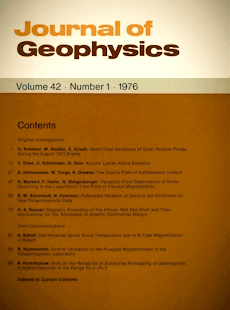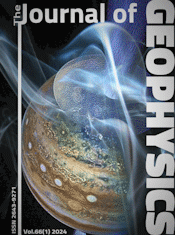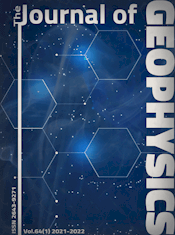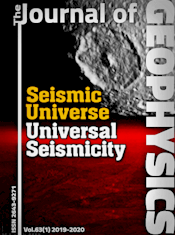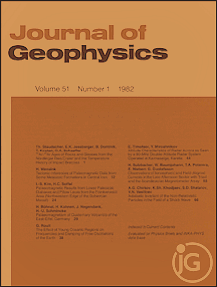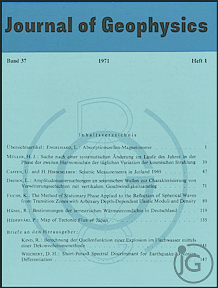Cosmic ray measurements on board Helios 1 from December 1974 to September 1975: Quiet time spectra, radial gradients, and solar events
Article Sidebar
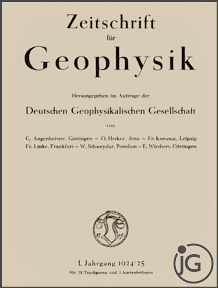
Vols. 1-18 (1924-1944), ISSN 0044-2801
Main Article Content
Abstract
The University of Kiel cosmic ray experiment on board Helios 1 measures nucleons above 1. 7 MeV/nucleon and electrons above 0.3 MeV in the inner solar system between 1.0 and 0.3 AU from the Sun. A first survey is given on quiet time proton and Helium spectra which are compared near Earth and close to perihelion. The anomalous Helium component is also present at radial distances within 0.4 AU. Quiet time Helium spectra from 3.8 to 48 MeV/nucleon gradually increase between December 1974 and June 1975. For the integral radial gradient (protons above 51 MeV) we estimate a value of (11±2.5) %/AU during a period of slowly increasing cosmic ray intensity. We discuss solar particle events on January 5 (at 0.93 AU), March 7 (at 0.41 AU), and March 19, 1975 (at 0.32 AU). The March 19 event was measured closer to the Sun than any other event before. It exhibits sharp temporal structures, differences in the time profiles of various particle species, and a large abundance of Helium 3, with a 3He/4He ratio of 2 to 3 in the range 5 to 7 MeV/nucleon. This event occurred close to the peak of a high speed solar wind stream.
 ARK: https://n2t.net/ark:/88439/y032443
ARK: https://n2t.net/ark:/88439/y032443
Permalink: https://geophysicsjournal.com/article/183
Article Details
References
Christon, S., Daly, S., Eraker, J.H., Lamport, J.E., Lentz, G., Simpson, J.A. (1975) Nucleon Radial Gradients between 0.45 and 1.0 AU from the Mariner-JO Mission to Mercury. Proceedings, 14th Internat. Cosmic Ray Conference, Munich, 1848-1849
Fisk, L.A. (1976a) The Acceleration of Energetic Particles in the Interplanetary Medium by Transit Time Damping. J. Geophys. Res., 81, 4633-4640
Fisk, L.A. (1976b) Solar Modulation and a Galactic Origin for the Anomalous Component Oserved in Low Energy Cosmic Rays. Astrophys. J., 206, 333-341
Fisk, L.A., Kozlovsky, B., Ramaty, R. (1974) An Interpretation of the Observed Oxygen and Nitrogen Enhancement in Low Energy Cosmic Rays. Astrophys. J., 190, L35-L37
Garcia-Munoz, M., Mason, M., Simpson, J.A. (1973) A New Test for Solar Modulation Theory: The 1972 May-July Low Energy Galactic Cosmic Ray Proton and Helium Spectra. Astrophys. J., 182, L81-L84
Garcia-Munoz, M., Mason, G.M., Simpson, J.A. (1975) The Anomalous 4He Component in the Cosmic Ray Spectrum at ::5 50 MeV per Nucleon during 1972-1974. Astrophys. J., 202, 265-275
Garrard, T.L., Stone, E.C., Vogt, R.E. (1973) The Isotopes of H and He in Solar Cosmic Rays. In: Ramaty, R., Stone, E.C. (Eds.) High Energy Phenomena on the Sun. Symposium Proceedings, pp. 341-354. Goddard Space Flight Center, Greenbelt, Maryland
Gloeckler, G. (1975) Low Energy Particle Composition. Proceedings, 14th Internat. Cosmic Ray Conference, Munich, 3784-3804
Green, G., Hasler, H.G., Kunow, H. (1970) An Adaptive Data Compression Method for a Cosmic Ray Experiment on Board a Space Probe. Nucl. Instrum. Methods, 86, 213-216
Green, G., Wibberenz, G., Muller-Mellin, R., Witte, M., Hempe, H., Kunow, H. (1975) Two Solar Cosmic Ray Events Measured on Helios I. Proceedings, 14th lnternat. Cosmic Ray Conference, Munich, 4257-4263
Hovestadt, D., Klecker, B., Vollmer, 0., Gloeckler, G., Fan, C.Y. (1975) Heavy Particle Emission of Unusual Composition from the Sun. Proceedings, 14th Internat. Cosmic. Ray Conference, Munich, 1613-1618
Hovestadt, D., Vollmer, O., Gloeckler, G., Fan, C.Y. (1973) Differential Energy Spectra of Low Energy (E < 8.5 MeV per Nucleon) Heavy Cosmic Rays During Solar Quiet Times. Phys. Rev. Letters, 31, 650-653
Klecker, B. (1977) The Anomalous Component of Low Energy Cosmic Rays-A Comparison of Observed Spectra with Model Calculations. To be published in J. Geophys. Res.
Kunow, H., Wibberenz, G., Green, G., Muller-Mellin, R., Witte, M., Hempe, H. (1975) Das Kieler Experiment zur Messung der Kosmischen Strahlung zwischen 1.0 und 0.3 AE. Raumfahrtforschung, 19, 253-257
Ma Sung, L.S., Van Hollebeke, M.A.I., McDonald, F.B. (1975) Propagation Characteristics of Solar Flare Particles. Proceedings, 14th Internat. Cosmic Ray Conference, Munich, 1767-1772
McDonald, F.B., Teegarden, B.J., Trainor, J.H., Webber, W.R. (1974) The Anomalous Abundance of Cosmic Ray Nitrogen and Oxygen Nuclei at Low Energies. Astrophys. J., 187, L105-L108
McKibben, R.B. (1975) Cosmic Ray Intensity Gradients in the Solar System. Rev. Geophys. and Space Phys., 13, 1088-1092
McKibben, R.B., Pyle, K.R., Simpson, J.A., Tuzzolino, A.J., O'Gallagher, J.J. (1975) Cosmic Ray Radial Intensity Gradients Measured by Pioneer 10 and Pioneer 11. Proceedings, 14th Internat. Cosmic Ray Conference, Munich, 1512-1517
Mewaldt, R.A., Stone, E.C., Vogt, R.E. (1975a) The Isotopic Composition of Hydrogen and Helium in Low Energy Cosmic Rays. Proceedings, 14th Internat. Cosmic Ray Conference, Munich, 306-311
Mewaldt, R.A., Stone, E.C., Vogt, R.E. (1975b) The Quiet-Time Spectra of Low Energy Hydrogen and Helium Nuclei. Proceedings, 14th Internat. Cosmic Ray Conference, Munich, 774-779
Reinhard, R. (1975) The Exponential Decay of Solar Flare Particles. II: Western Hemisphere Events. Proceedings, 14th Internat. Cosmic Ray Conference, Munich, 1687-1691
Reinhard, R., Wibberenz, G. (1974) Propagation of Flare Protons in the Solar Atmosphere. Solar Phys., 36, 473-494
Schulze, B.M., Richter, A.K., Wibberenz, G. (1975) On the Influence of Injection Profiles and of Interplanetary Propagation on the Time-Intensity and Time-Anisotropy-Profiles of Solar Cosmic Rays at I AU. Proceedings, 14th Internat. Cosmic Ray Conference, Munich, 1749-1753
Schwenn, R., Montgomery, M.D., Rosenbauer, H., Miggenrieder, H., Bame, S., Hansen, R.T. (1976) The Latitudinal Extend of High Speed Streams in the Solar Wind: Correlations of Helios, Imp, and K-Corona Measurements. (Abstract). EOS, Transactions Am. Geophys. Union, 57, 999
Serlemitsos, A.I., Balasubrahmanyan, V.K. (1975) Solar Particle Events With Anomalously Large Relative Abundance of 3He. Astrophys. J., 198, 195-204
Solar-Geophysical Data (1975) Solar-Geophysical Data, 366 through 375, Part I, U.S. Department of Commerce. February-November
Stoker, P.H., Carmichael, H. (1971) Steplike Changes in the Long-term Modulation of Cosmic Rays. Astrophys. J., 169, 357-368
Teegarden, B.J., McDonald, F.B., Trainor, J.H., Roelof, E.C., Weber, W.R. (1973) Pioneer 10 Measurements of the Differential and Integral Cosmic Ray Gradient between 1 and 3 AU. Astrophys. J., 185, Ll55-Ll59
Webber, W.R., McDonald, F.B., Trainor, J.H., Teegarden, B.J., Von Rosenvinge, T.T. (1975) Further Studies of the New Component of Cosmic Rays at Low Energies. Proceedings, 14th Internat. Cosmic Ray Conference, Munich, 4233-423.8
Zamov, R. (1975) The 1964-1972 quiet-time spectra of protons and helium at 2-20 MeV/N. Astrophys. J., 197, 767-780


